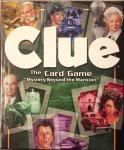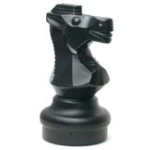 Personally, I think it's fun to take things out of their expected uses, and see how I can use them in a performance of magic, memory or mental math. Besides the previous entry, I've also talked about different uses for numbered cards, DVDs, the 15 puzzle, calendars, celebrity names and more!
Personally, I think it's fun to take things out of their expected uses, and see how I can use them in a performance of magic, memory or mental math. Besides the previous entry, I've also talked about different uses for numbered cards, DVDs, the 15 puzzle, calendars, celebrity names and more!
My latest discovery is Clue: The Card Game. It's similar to the classic board game of the same name, but there is no board, and the game itself focuses more on solving the crime than the original. In Clue: The Card Game, Mr. Boddy has been murdered again, and you're supposed to figure out who did it, what their getaway vehicle was, and to what famous landmark they're headed.
Instead of using it for the game, I recognized that the included cards are perfect for a different version of a classic, yet rarely-discussed, memory feat. In this feat, you have each of 6 spectators select one of the suspect cards (Colonel Mustard, Mrs. Peacock, Mr. Green, Miss Scarlet, Professor Plum or Mrs. White), one of the getaway vehicle cards (Airliner, Automobile, Hot Air Balloon, Limousine, Seaplane or Train) and one of the destination cards (The Alamo, Coney Island, Old Faithful, Golden Gate Bridge, Hoover Dam, Lincoln Memorial, Miami Beach, Niagra Falls or Mt. Rushmore). As they make their selections, they announce them out loud, and show them to you.
Using the Link System, you mentally memorize the selected combinations. For example, if the first person selects Colonel Mustard, who travels by limousine to Hoover Dam, you might picture a limosine with a jar of mustard jumping out, and then sliding down the face of Hoover Dam. You would do this for each of the 6 spectator's combinations.
Once you have the combinations linked, you ask each of the audience members to give you the name of any one of their cards. You can then recall the other two cards in their hand! If one person says, “limousine”, you can instantly recall that Colonel Mustard took it to Hoover Dam! If someone else says, “Professor Plum”, you might recall that he took a balloon to Mt. Rushmore (or whatever the combination was).
This may not sound like much, but being able to recall 18 details (6 spectators times 3 details each) out of 324 possible combinations (6 suspects times 6 getaway vehicles times 9 destinations) comes across as very impressive! Performing this as if you were a detective who is solving crimes also makes this much more entertaining than remembering a list of 20 random items, which is the classic use for the link technique.
Speaking of perfoming this as a detective, you could also take this demonstration a step further, and make it more in keeping with the classic spirit of Clue. For the improved version, you would simply eliminate 3 of the destination cards, giving you 6 suspects, 6 getaway vehicles and 6 destinations. You would, of course, have to memorize the contents of each set via linking, as well.
Once you've prepared yourself and the cards in this way, you would have 5 (instead of 6) spectators each select card combinations. When the combinations are called out during selection, you not only have to link them to each other, but picture each item frozen in a giant block of ice, as well. For our earlier example of Colonel Mustard taking the limousine to the Hoover Dam, you would picture a jar of mustard frozen in a block of ice, hopping out of a limousine frozen in a block of ice, sliding down Hoover Dam, which is also frozen in a block of ice.
Once you've recalled all the combinations, as in the original version above, you point out that there are 3 cards which weren't selected. You then reveal the 3 cards that were never picked! How?
You go through your list of memorized suspects, and recall which one wasn't frozen in a block of ice! You also do the same for the list of vehicles and the destinations. As long as you've memorized the complete sets of each, it shouldn't take long to recall which ones were never imagined as being encased in ice. If you go through your lists, and realize the Professor Plum, the seaplane, and the Lincoln Memorial weren't encased in ice, then the remaining cards must be those three!
Try either version of this feat, add your own presentational touches, and have fun with it!

 Back in March, I announced that Arthur Benjamin and Michael Shermer were releasing a new book in August 2006. However, according to this page from the Skeptic store, this is apparently not the case.
Back in March, I announced that Arthur Benjamin and Michael Shermer were releasing a new book in August 2006. However, according to this page from the Skeptic store, this is apparently not the case.





 Every so often, I run across regular items that are perfect for use in a mental feat demonstration, such as
Every so often, I run across regular items that are perfect for use in a mental feat demonstration, such as  Many of you may know Terry LaGerould from
Many of you may know Terry LaGerould from  Yes, I've been neglecting the
Yes, I've been neglecting the 

